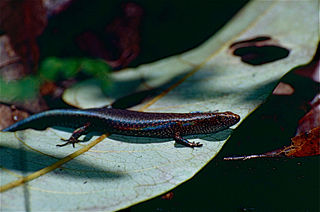
Lampropholis is a genus of skinks, commonly known as sunskinks, in the lizard subfamily Eugongylinae of the family Scincidae. The genus Lampropholis was previously found to belong to a clade with the genera Niveoscincus, Leiolopisma and others of the Eugongylus group within Lygosominae. All species of Lampropholis are endemic to Australia. For similar skinks see genera Bassiana, Pseudemoia, and Niveoscincus.
Allan's lerista, also known commonly as Allan's skink and the greater robust fine-lined slider, is a species of skink, a lizard in the family Scincidae. This rare species is endemic to Queensland, Australia.
The Satinay sand skink, also known commonly as the Fraser Island sand skink, is a species of lizard in the family Scincidae. The species is native to Australia.
Patrick J. Couper is a herpetologist in Queensland, Australia. Born in New Zealand, he migrated to Australia in 1981. Couper began his career at the Queensland Museum in 1984. He was initially employed in display construction, and became a research assistant in herpetology in 1986 under the direction and mentorship of the admired senior curator and head of Vertebrate Zoology, Jeanette Covacevich. Since 1993 he has been Curator of Reptiles and Amphibians at the Queensland Museum. A major research focus has been leaf-tailed geckos that inhabit rainforest and rock habitats in eastern Queensland and New South Wales.

The major skink is a species of lizard in the family Scincidae. The species is native to part of Australia and part of Australasia.

Carlia schmeltzii, known commonly as the robust rainbow-skink, is a species of lizard in the family Scincidae. The species is endemic to Australia.
Lampropholis adonis, also known commonly as the diamond shielded sunskink and Ingram's litter skink, is a species of skink, a lizard in the family Scincidae. The species is endemic to Queensland in Australia.
Lampropholis caligula, also known commonly as the montane sunskink or the montane sun skink, is a species of lizard in the family Scincidae. The species is endemic to New South Wales in Australia.

Lampropholis coggeri, also known commonly as the northern sun skink and the rainforest sunskink, is a species of lizard in the family Scincidae. The species is endemic to Queensland in Australia.
Lygisaurus tanneri, also known commonly as the Endeavour River litter-skink and Tanner's four-fingered skink, is a species of lizard in the family Scincidae. The species is endemic to Australia.

Saproscincus challengeri, also known commonly as the Border Ranges shadeskink, Challenger's skink, the challenging shade skink, and the orange-tailed shadeskink, is a species of lizard in the family Scincidae. The species is native to New South Wales and Queensland in Australia.

Saproscincus czechurai, also known commonly as Czechura's litter-skink, Czechura's skink, and the wedge-snouted shadeskink, is a species of lizard in the family Scincidae. The species is endemic to Queensland in Australia.
Praeteropus gowi, also known commonly as Gow's burrowing skink and the speckled worm-skink, is a species of lizard in the family Scincidae. The species is endemic to Queensland in Australia.
Concinnia frerei, also known commonly as the stout bar-sided skink or the stout barsided skink, is a species of lizard in the family Scincidae. The species is endemic to Queensland in Australia.
Ctenotus astarte, also known commonly as the stony downs ctenotus, is a species of skink, a lizard in the family Scincidae. The species is endemic to Australia.
Ctenotus eurydice, also known commonly as the brown-backed yellow-lined ctenotus, is a species of skink, a lizard in the family Scincidae. The species is native to New South Wales and Queensland in Australia.
The nubbinned fine-lined slider is a species of skink, a lizard in the family Scincidae. The species is endemic to Queensland in Australia.
Lerista emmotti, also known commonly as the Noonbah robust slider, is a species of skink, a lizard in the family Scincidae. The species is endemic to Queensland in Australia.
Lerista ingrami, also known commonly as the McIvor River slider, is a species of skink, a lizard in the family Scincidae. The species is endemic to Queensland in Australia.
Lerista karlschmidti, also known commonly as the lesser robust fine-lined slider, Karl's lerista, and Karl Schmidt's lerista, is a species of skink, a lizard in the subfamily Sphenomorphinae of the family Scincidae. The species is native to the Northern Territory and Queensland in Australia. Its range is highly disjunct and it is likely that only the Queensland population represents L. karlschmidti, while the Northern Territory population is a distinct species.







